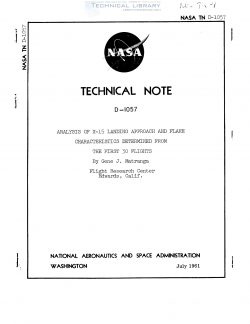NASA-TN-D-1057
- Version
- 65 Downloads
- 2.36 MB File Size
- 1 File Count
- July 6, 2017 Create Date
- July 6, 2017 Last Updated
Analysis of X-15 Landing Approach and Flare Characteristics Determined from the First 30 Flights

The approach and flare maneuvers for the first 30 flights of the
X—l5 airplane and the various control problems encountered are discussed.
The results afford a relatively good cross section of landing conditions
that might be experienced with future glide vehicles having low lift-
drag ratios.
Flight-derived drag data show that preflight predictions based on
wind-tunnel tests were, in general, somewhat higher than the values
measured in flight. Depending on configuration, the peak lift-drag
ratios from flight varied from 3.5 to 4.5 as compared with a predicted
range of from 3.0 to h.2.
By employing overhead, spiral—type patterns beginning at altitudes
as high as h0,000 feet, the pilots were consistently able to touch down
within about il,OOO feet of a designated point.
A typical flare was initiated at a ”comfortable” altitude of about
800 feet and an indicated airspeed of approximately 300 knots, which
allowed a margin of excess speed. The flap and gear were extended
when the flare was essentially completed, and an average touchdown was
accomplished at a speed of about 185 knots indicated airspeed, an angle
of attack of about 7°, and a rate of descent of about A feet per second.
In general, the approach and landing characteristics were predicted
with good accuracy in extensive preflight simulations. F-IOM airplanes
which simulated the X-15 landing characteristics were particularly
valuable for pilot training.
Prior to the first flight of the X-l5, it was apparent from wind-
tunnel tests that the landing approach and flare maneuvers would be
performed in a range of lift—drag ratios lower than previously flown
with rocket—propelled aircraft (ref. 1). Sirce piloting problems were
anticipated, analytical and flight-test studies were undertaken by the
NASA Flight Research Center, the manufacturer (North American Aviation,
Inc.), and the Air Force Flight Test Center To determine how well the
pilot could execute approach and flare maneuyers at reduced lift—drag
ratios. References l to 3 are illustrative cf these investigations.
| File | Action |
|---|---|
| NASA-TN-D-1057 Analysis of X-15 Landing Approach and Flare Characteristics Determined from the First 30 Flights.pdf | Download |
Comment On This Post